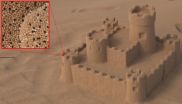Computer graphics: Less computing time for sand
KIT, Disney Research, and Cornell University develop process for efficient computation of photo-realistic images of granular materials, such as sand, snow, salt, or sugar
2015-09-04
(Press-News.org) "Objects of granular media, such as a sandcastle, consist of millions or billions of grains. The computation time needed to produce photorealistic images amounts to hundreds to thousands of processor hours," Professor Carsten Dachsbacher of the Institute for Visualization and Data Analysis of KIT explains. Materials, such as sand, salt or sugar, consist of randomly oriented grains that are visible at a closer look only. Image synthesis, the so-called rendering, is very difficult, as the paths of millions of light rays through the grains have to be simulated. "In addition, complex scattering properties of the individual grains and arrangement of the grains in a system can prevent classical acceleration techniques from being used. This makes it difficult to find efficient algorithms," doctoral student Johannes Meng adds. "In case of transparent grains and long light paths, computation time increases disproportionately."
For image synthesis, the researchers developed a new multi-scale process that adapts simulation to the structure of light transport in granular media on various scales. On the finest scale, when only few grains are imaged, geometry, size, and material properties of individual discernable grains as well as their packing density are considered. As in classical approaches, light rays are traced through the virtual grains, which is referred to as path tracing. Path tracing computes light paths from each pixel back to the light sources. This approach, however, cannot be applied to millions or billions of grains.
The new process automatically changes to another rendering technique, i.e. volumetric path tracing, after a few interactions, such as reflections on grains, provided that the contributions of individual interactions can no longer be distinguished. The researchers demonstrated that this method normally applied to the calculation of light scattering in materials, such as clouds or fog, can accurately represent and more efficiently compute light transport in granular materials on these scales.
On larger scales, a diffusion approximation can be applied to produce an analytical and efficient solution for remaining light transport. This enables efficient computation of photorealistic representation in case of bright and strongly reflecting grains, such as snow or sugar.
The researchers also succeeded in demonstrating how the individual techniques have to be combined to produce consistent visual results on all scales - from individual grains to objects made of billions of grains - in images and animations. Depending on the material, the hybrid approach accelerates computation by a factor of ten up to several hundreds compared to conventional path tracing, while image quality remains the same.
INFORMATION:
Link to the publication on computer graphics, visual computing, and geometry processing by the KIT Institute for Visualization and Data Analysis: http://cg.ivd.kit.edu/granular_media.php
Video on the new method: https://youtu.be/q6p7jLELGXU
More information: http://www.eurekalert.org/pub_releases/2015-08/dr-drm080415.php
Karlsruhe Institute of Technology (KIT) is a public corporation pursuing the tasks of a Baden-Wuerttemberg state university and of a national research center of the Helmholtz Association. The KIT mission combines the three core tasks of research, higher education, and innovation. With about 9,400 employees and 24,500 students, KIT is one of the big institutions of research and higher education in natural sciences and engineering in Europe.
Since 2010, the KIT has been certified as a family-friendly university.
[Attachments] See images for this press release:

ELSE PRESS RELEASES FROM THIS DATE:
2015-09-04
Nowadays, internet auctions play an important role in online trading. No matter whether you want to buy a hedge trimmer or an antique pocket watch - unlike purchases by a click at a fixed price, online auctions provide the atmosphere of a competition for the auction object. Whoever perceives the competition of real contenders, e.g. by avatars or photos on the screen, wishes to stay in the race - and increases his bid. This is a result of a KIT study with more than 450 test persons.
Online auctions combine shopping with entertainment, fun, and excitement. This is the ...
2015-09-04
Action to prevent tooth decay in children, such as supervised tooth brushing and fluoride varnish schemes, are not just beneficial to children's oral health but could also result in cost savings to the NHS of hundreds of pounds per child, so says a leading dental health researcher.
Professor Elizabeth Kay, Foundation Dean of the Peninsula Dental School from Plymouth University Peninsula Schools of Medicine and Dentistry, has carried out the first economic evaluation of public health measures to reduce tooth decay in children at high risk, in association with the National ...
2015-09-04
When a jogger sets out on his evening run, the active movements of his arms and legs are accompanied by involuntary changes in the position of the head relative to the rest of the body. Yet the jogger does not experience feelings of dizziness like those induced in the passive riders of a rollercoaster, who have no control over the abrupt dips and swoops to which they are exposed. The reason for the difference lies in the vestibular organ (VO) located in the inner ear, which controls balance and posture. The VO senses ongoing self-motion and ensures that, while running, ...
2015-09-04
Patients with cancer of the esophagus--also known as the gullet--are often given chemo- or radiotherapy, with the aim of shrinking the tumor before it is surgically removed. Increasingly positron emission tomography (PET) is being used to monitor the size of the tumor during the treatment. To date, however, no benefit for patients has ensued, as Milly Schröer-Günther and co-authors show in an original article in the current issue of Deutsches Ärzteblatt International (Dtsch Arztebl Int 2015; 112: 545-52).
PET is an imaging technique that makes a tumor in ...
2015-09-04
Despite continued medical advances, infectious diseases kill over 10 million people worldwide each year. The ecological complexity of many emerging disease threats--interactions among multiple hosts, multiple vectors and even multiple parasites--often complicates efforts aimed at controlling disease. Now, a new paper co-authored by a University of Colorado Boulder professor is advancing a multidisciplinary framework that could provide a better mechanistic understanding of emerging outbreaks.
In a study published today in the journal Science, researchers demonstrate how ...
2015-09-04
In the game of wheat genetics, Jorge Dubcovsky's laboratory at UC Davis has hit a grand slam, unveiling for the fourth time in a dozen years a gene that governs wheat vernalization, the biological process requiring cold temperatures to trigger flower formation.
Identification of the newly characterized VRN-D4 gene and its three counterpart genes is crucial for understanding the vernalization process and developing improved varieties of wheat, which provides about one-fifth of the calories and proteins that we humans consume globally.
The new study, reported online in ...
2015-09-04
Girls with autism display less repetitive and restricted behavior than boys do, according to a study by researchers at the Stanford University School of Medicine.
The study also found that brain differences between boys and girls with autism help explain this discrepancy.
The study, which will be published online Sept. 3 in Molecular Autism, gives the best evidence to date that boys and girls exhibit the developmental disorder differently.
"We wanted to know which specific clinical manifestations of autism show significant gender differences, and whether patterns ...
2015-09-04
Each extra hour per day spent watching TV, using the internet or playing computer games during Year 10 is associated with poorer grades at GCSE at age 16, according to research from the University of Cambridge. In a study published today in the open access International Journal of Behavioral Nutrition and Physical Activity, researchers also found that pupils doing an extra hour of daily homework and reading performed significantly better than their peers. However, the level of physical activity had no effect on academic performance.
The link between physical activity ...
2015-09-04
Metabolic or bariatric surgery may be more effective than standard medical treatments for the long-term control of type 2 diabetes in obese patients, according to a new study by King's College London and the Universita Cattolica in Rome, Italy. The study, published in the Lancet, is the first to provide data on five-year outcomes of surgery from a randomized clinical trial specifically designed to compare this new approach against standard medical therapy for the treatment of type 2 diabetes.
A number of studies have shown that bariatric or weight-loss surgery can result ...
2015-09-04
Astronomers from the University of Cambridge have developed a new, highly accurate method of measuring the distances between stars, which could be used to measure the size of the galaxy, enabling greater understanding of how it evolved.
Using a technique which searches out stellar 'twins', the researchers have been able to measure distances between stars with far greater precision than is possible using typical model-dependent methods. The technique could be a valuable complement to the Gaia satellite - which is creating a three-dimensional map of the sky over five years ...
LAST 30 PRESS RELEASES:
[Press-News.org] Computer graphics: Less computing time for sand
KIT, Disney Research, and Cornell University develop process for efficient computation of photo-realistic images of granular materials, such as sand, snow, salt, or sugar


